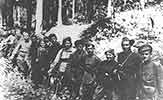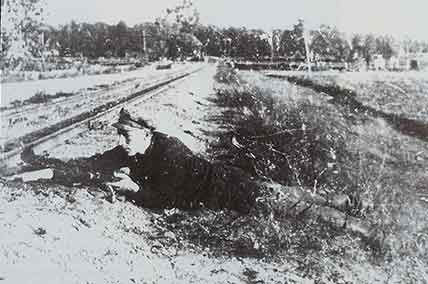General Dwight D. Eisenhower
Supreme Commander of the Allied Forces
Sabotage of Grodno Railway and Communication Lines
In the forest, under Abba Kovner's command the escapees of the Vilna ghetto became fighting partisans. There were four Jewish partisan detachments in the
Rudnicki forest: "The Avenger's," "For Victory," "Death of Fascism," and the "Struggle" battalion. In total there were about 300 Jewish partisans associated with them, of which about two hundred escaped from the Vilna ghetto, the others came from areas surrounding Vilna such as Kovno.
2

|
Rudnicki Partisans
* Leyzer Ran
|
They had limited weapons, not enough for the entire group. The Russian partisans received drop shipments of goods into the forest from Moscow. The Jewish partisans hoped for Russian cooperation since

|
Partisan Sabatoge
* Leyzer Ran
|
they had plenty of weapons to go around, but they refused to arm them. In many instances the Russian partisans, like the Polish, and Lithuanian partisans were anti-Semitic, and the Jews had to watch their backs.
2 Although they were fighting the same battle against the Nazis, the Jews were not welcomed.

|
Derailed Nazi Train
* Leyzer Ran
|
The Jewish partisans focused on doing whatever they could to slow down the German war machine. They began to cut down the communication lines. Groups of mostly men, would go out on nightly missions to derail Nazi trains.
4 They never knew what was being carried on the east - west trains traveling the Grodno railway. All they knew was the trains were headed to the battle front. Sometimes German troops would come out shooting, but the partisans were very quick to
head back into the heavily dense forest that protected them.
5 M. Gurwitz, a main line fighter recalled going out on many missions to blow up trains,
"Two groups would go out on a mission at the same time. One group would place explosives along the weak points of the railroad track, then attach something like a cord. No one had matches, so one would smoke and light the explosive with the cigarette. The other group would cut telephone poles."6
The Germans never followed them back into the forests. Instead the Germans gave weapons to the locals to shoot, and hunt down the partisans.
Back to Top
Food & Survival
The most dangerous missions for the Jewish partisans were missions for the purpose of obtaining food and needed weapons from the local farmers.7 According to several mainline fighters,
"We suffered more casualties from our expeditions to find food than we did blowing up trains, bridges, railway lines, and telegraph poles in our fight against the Germans. These raids were always carried out at night and usually ran into day light hours. A fully ladened wagon train took hours to reach base."8
"One evening three lads, led by Shlomo Brand...took several wagonloads of food from the village, returning to the forest under a torrent of bullets...Sometimes partisans were killed and wounded in forays. Generally, they had to abandon the wagons to fight the Germans, and they returned to camp empty handed."9
The Jewish partisans had three hundred mouths to feed in the forest. Prior to the onset of war, the youth

|
Food Missions
* Leyzer Ran
|
affiliated with political groups such as Betar and HaShomer Hatzair aspired to go to Palestine, however the difference between the groups was that Betar had military-like training, and the HaShomer Hatzair had training in agriculture and outdoor survival. But neither were prepared for living in the medieval forest. Forest living was harsh.

|
Setting Mines
* Leyzer Ran
|
The forest was a large swampy marsh and in the summer the mosquitoes swarmed the area. And of course, there was always the issue of fleas and lice. The winter of 1943 was one of the coldest on record. When the partisans of Vilna had initially escaped from the ghetto to the forest they came with the clothes on their backs. Warm clothing and boots were essential. Without gloves, jackets and a good pair of boots, the partisans traveling through cold and snow suffered from frost bite.
10 Escapees of Ponary
Seventy Jews, 9 Russians, and 1 Pole were kept as prisoners at Ponary by the Nazis to open up the mass graves of victims buried in large pits originally constructed during the

|
Jews forced to exhume bodies
* Leyzer Ran
|
Russian occupation of Vilna. The large pits were initially constructed for the storage of fuel, but later were made into an extermination site by the Nazis. The prisoners were forced to first dig up victim's bodies, pictured to the left. Then later, build pyres to burn
the bodies who had been buried there. The prisoners were ordered to cover up Nazi war crimes. Under armed guard Nazi command, the prisoners

|
Jews marched in chains to work at Ponary
* Leyzer Ran
|
were marched shackled in chains to work, pictured to the right. Of the eighty prisoners, during a planned escape on May 19, 1944, eleven, and possibly twelve were able to escape with their lives. The rest of the group was gunned down. The Jewish partisans in the Rudnicki forest

|
Dogim's Note of Remembrance
* Leyzer Ran
|
heard about the escape, and were trying to locate the prisoners before they were caught by locals and turned into enemy hands. Several were found by Jewish partisans on the lookout for them. Several were housed in the Avenger's bunkers. One of the escapees, I. Dogim noted that he "carried to the bonfire for cremation": his mother, wife, three sisters, and two nieces. His hand written note of remembrance is pictured to the left.
11
In a videotaped interview at
Ponary standing in front of a large pit, a member of the Avenger's camp recalled a prisoner's account,
"After the ghetto's liquidation, the Germans started to hide the traces of their crimes--there was 100,000 people who perished here [at Ponary]. They brought here physically strong Jewish men, and some prisoners of war. There were four women in the group who cooked. The work was physically exhausting. It was over here [she points to the pit]. Inside [the pit] there was a bunker where the group lived in an underground dug out. The group was divided into brigades. There was one brigade responsible for the firewood 3-6 meters long. The second brigade was digging out corpses--they had long hooks. They would put a layer of firewood and a layer of corpses. Afterwards, there was a person responsible for taking out the golden teeth--the doctor. Then they would make a fireplace, it was very high. The fireplace had a special elevator--as the corpses burned, they watched to see if the bones were still hard. The fire would burn for one week. Afterwards they would check again for any remaining hard bones, and if there were some they used a hammer to break them up. And they had a net to find gold and stones and then they were suppose to mix the ashes with the earth. The group was still burying corpses. Apparently, the people were not from Lithuania, they were mostly from Austria...They were shot here."12
Photo Gallery:
Notes
1. Kowalski, A Secret Press of Nazi Germany, 324.
2. Ibid., 405 - 407. Kowalski lists 300 names of partisans in the Rudnicki forest, these names do not include partisans in the Naroch forest; Arad, Ghetto in Flames: The Struggle and Destruction of the Jews in Vilna in the Holocaust, 456 - 7. Note: According to Arad the first groups from the Vilna ghetto to arrive in the forest totaled 150. Several more groups from Kailis work camp swelled the number in the forest to 350.
3. Arad, Ghetto in Flames, 459; Levin, Fighting Back, 205 - 209; Kowalski, A Secret Press of Nazi Germany,326 - 329, 346.
4. Arad, Ghetto in Flames, 458; Levin, Fighting Back, 196 - 198. Levin details the military achievements of Vilna's partisans, the four detachments.
5. Kowalski, A Secret Press of Nazi Germany, 324.
6. Videotaped interview of M. Gurwitz in 2005.
7. Harmatz, From the Wings, 85; Arad, Ghetto in Flames, 457.
8. Harmatz, From the Wings, 85.
9. Lazar, Destruction and Resistance, 134 - 135.
10. Harmatz, From the Wings, 83.
11. Ibid., 92 - 97; Kowalski, A Secret Press of Nazi Germany, 298 - 306.
12. Videotaped interview of F. Jocheles-Brancovski in 2004.







